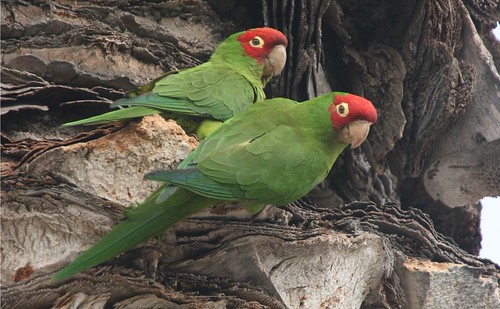Be they natives or imports, enjoy L.A.'s birds
 Tuesday, March 31, 2009 at 10:25
Tuesday, March 31, 2009 at 10:25  Wild parrots are no more unnatural to the Southland skies than, say, house sparrows.The feral parrots were freaking me out.
Wild parrots are no more unnatural to the Southland skies than, say, house sparrows.The feral parrots were freaking me out.
They are avian interlopers from the south, and with their iridescent mustard-and-emerald plumage they are impossible to miss.
You see flocks of them dipping and darting over the bumper-to-bumper traffic at certain San Gabriel Valley intersections, or perched on palm trees overlooking mini-mall parking lots.
Take one look at their tropical coloring, listen to their loud jungle squawks and you might say to yourself, as I did: These birds don't belong here.
The feral parrots are the descendants of caged pets and birds kidnapped from rain forests. Their real homes are in the vast plains of the Amazon and the steamier corners of Mexico and Guatemala, thousands of miles to the south.
Watching a flock of about 20 flapping loudly and taking off over a supermarket in South Pasadena, I wondered if they were a danger to the landscape. It feels like a silly thing to write now, but this is what I felt then: The feral parrots offended the California purist in me.
 Red-crowened Amazon parrots are a real treat from the valleySo I called one of the leading bird experts in Los Angeles County, Kimball Garrett, author of books on the birds of our region. Garrett is a native Angeleno who's been tracking birds since he was a kid in the 1960s living on the edge of Griffith Park.
Red-crowened Amazon parrots are a real treat from the valleySo I called one of the leading bird experts in Los Angeles County, Kimball Garrett, author of books on the birds of our region. Garrett is a native Angeleno who's been tracking birds since he was a kid in the 1960s living on the edge of Griffith Park.
After talking to Garrett for an hour, it was clear that I was guilty of a sin common to journalists everywhere. We get so caught up with the strange, the annoying and the disturbing, that we fail to notice and tell of the enduring beauty of the everyday.
Garrett and I started talking about feral parrots and ended up with hooded orioles, mockingbirds and the elusive great-tailed grackle.
He didn't seem especially worried about the parrots.
"There go a couple of yellow-chevroned parakeets right now," he told me, pointing out the window of his office at the Natural History Museum of Los Angeles County, at Exposition Park.
Garrett said the appearance of the feral parrots a couple of decades ago was just another episode in a century and a half of history in which the region's flora and fauna have undergone great changes, thanks to human activity.
Look at a photograph of mid-19th century Los Angeles, for example, and you'll see hardly any trees. The planting of countless fruit trees and palms helped change the avian universe around us.
"We don't have pristine anything anymore," Garrett said. "And we are way beyond the point of insisting that our ecosystems remain pure and free of nonnative species."
The yellow-chevroned parakeet is from Brazil. Here in Southern California it enjoys feeding on the silk-floss tree, a big-canopied tree also native to South America.
"Both the parakeets and the trees have been artificially transported here, and now they've been reunited here," Garrett said.
Some of the most common birds in the L.A. landscape come from elsewhere, including house sparrows, which were brought from Europe and first released in Brooklyn in 1851.
But there is still an essential Southern California character to the landscape, thanks to the native species that thrive here. And in these last days of March, which are also the first days of spring, many of our native birds are quite busy.
The hooded orioles began appearing in Southern California backyards just a week or so ago. Brilliant yellow with a black face and black wings, they're completing a long trip from the southern half of the Baja peninsula.
The swallows get all the publicity, but the hooded orioles are just as punctual.
The hooded orioles are a native species, but they like to nest in palm trees, none of which are native to Los Angeles County. They build little pouches attached to the underside of palm fronds, and the presence of so many palms has allowed the population to increase, Garrett said.
Other native species have grown more abundant and spread their range, like the great-tailed grackle, a bird with a long, keel-shaped tail that is common in Mexico.
With the spread of agriculture and human settlement, the great-tailed grackle has spread slowly northward. When one showed up in San Pedro about 30 years ago, "People raced down to see it," Garrett said.
"By the 1980s, they established populations in L.A.," he said. "Now you can go and see 50 in Echo Park." They've become one of our most conspicuous and noisy birds.
But there are also certain species that once dotted the Los Angeles of Raymond Chandler and even Sam Yorty but which are hardly ever seen inside the city limits anymore.
The loggerhead shrike is a small gray-and-white bird with a black Zorro mask over its eyes. Once it thrived on the city's open grasslands.
"I used to see them in Exposition Park," Garrett said. "Now they've virtually disappeared from the Los Angeles coastal regions. I saw one a couple of weeks ago in the San Fernando Valley and I got excited."

